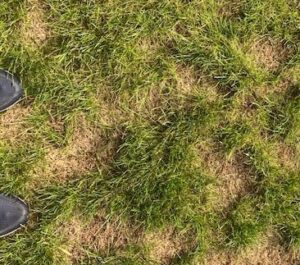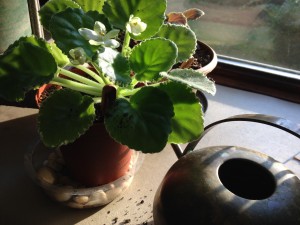Hello fellow readers, We planted Ellie’s memorial tree over the weekend, a ‘Baby Blue Eyes’ Blue Spruce that served as our Christmas tree. It was a heartfelt moment as Jolee stood nearby watching. And, she helped dig a few holes in the yard too. Yup, we have a digger dog on our hands. Gardening with dogs can sure be a dilemma!
Solutions to the dilemma of digger dogs:

Certain breeds such as terrier, dachshund, and others bred to hunt burrowing animals have digging instincts you cannot break. Some suggest setting up a sandbox to keep them out of the garden. Bury treats or toys, lead them to their box when the dig urge strikes, and then demonstrate by digging yourself. Warning— this technique may backfire if you have outdoor cats (smile).
Bill from Bangor, PA, suggests never letting your dog watch you plant as she’ll think you’re burying something tasty, and chances are she will go back and dig up your plants. What a great tip— garden in the dark :^).
What about the dog dilemmas of trampling, noshing, and lawn spots?
Doggone diggers are only part of the challenge. In addition, there’s the risk of trampling while playing, noshing while bored, yellow lawn spots, or leg lifting on branches.
Many dogs love eating grass; that includes my dear Miss Ellie. Despite efforts to keep her away from the fountain grass, mine were topless before they ever bloomed. She’s likely smiling from above to see that Jolee has the same appetite. They say Bitter Apple spray used to train them not to chew doesn’t harm plants, but Ellie thought it was delicious too.
 My first couple of puppies, littermates Sara and Sadie, provided a jumpstart on dog parenting. That first spring, I planted an ambitious perennial garden and took precautions to deter deer with Bobbex, an organic spray. Deer stayed away; pups rolled, perennials flattened, lesson learned. Pick a deer spray that doesn’t smell like a decaying animal.
My first couple of puppies, littermates Sara and Sadie, provided a jumpstart on dog parenting. That first spring, I planted an ambitious perennial garden and took precautions to deter deer with Bobbex, an organic spray. Deer stayed away; pups rolled, perennials flattened, lesson learned. Pick a deer spray that doesn’t smell like a decaying animal.
Choose dog-friendly garden plants.
And choose plants that readily spring back from trampling or rolling, especially on the edge of your garden. Good bets are Coral bells (Heuchera), Catmint (Nepeta), Lamb’s Ear (Stachys) and Bugleweed (Ajuga). There’s Bearberry (Arctostaphylos uva-ursi), Creeping Thyme such as Thymus praecox, low growing Stonecrop (Sedum acre), Wormwood (Artemisia), and Tickseed (Coreopsis)— all tough plants and deer resistant.
You can set large boulders to guard tender plants or prized shrubs. And save your delicate plants for pots interspersed in your garden. River stone along the border of your garden may also help as dogs prefer a smooth surface.
Designated potty spots are a matter of training, but marking territory (leaving pee-mail) is an instinct that is tough to control. However, you can create marking spots with pieces of driftwood that can also serve as border guards at the edge of your garden. And, keeping your lawn three to four inches high hides the yellow spots and helps deter weeds.
 Jolee’s fascination with Mom’s African Violets
Jolee’s fascination with Mom’s African Violets
Speaking of pots, for some mysterious reason, Jolee has managed to attack, okay, decimate, a few African violets that were once Mom’s. Other plants that sit on the bay windowsill remain untouched. I salvaged a leaf from the first causality and rooted it in a tiny pot. Then, just this morning, I noticed the baby pot is missing. Only the one-inch saucer remains. Mom would be laughing (better to laugh than cry). The good news, according to the ASPCA’s list of toxic and non-toxic plants, African Violets are non-toxic.
Jolee’s puppy enthusiasm comes with beneficial qualities too. Like her finesse at pouncing cave crickets.”Leave it,” I say, encouraging her not to indulge. Instead, she stares back, likely with a tickle in her throat.
Garden Dilemmas? AskMaryStone@gmail.com (and your favorite Podcast App.)
Link to the story about Ellie’s Living Christmas Tree
And, to a previous column on Pet-Friendly Plants
Visit the ASPCA website for toxic and non-toxic plants.



